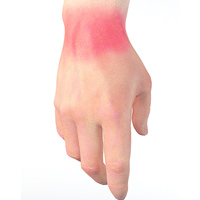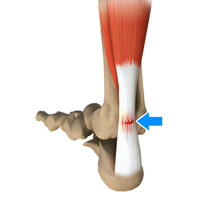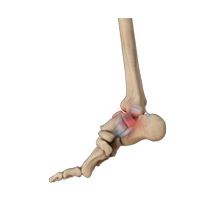Sports Medicine
Sports injuries occur when playing indoor or outdoor sports or while exercising. They can result from accidents, inadequate training, improper use of protective devices, or insufficient stretching or warm-up exercises. The most common sports injuries are sprains and strains, fractures and dislocations.
The most common treatment recommended for injury is rest, ice, compression and elevation (RICE).
- Rest:Avoid activities that may cause injury.
- Ice:Ice packs can be applied to the injured area, which will help reduce swelling and pain. Ice should be applied over a towel on the affected area for 15-20 minutes, four times a day, for several days. Never place ice directly over the skin.
- Compression:Compression of the injured area also helps reduce swelling. Elastic wraps, air casts and splints can accomplish this.
- Elevation:Elevate the injured part above your heart level to reduce swelling and pain.
Some of the measures that are followed to prevent sports-related injuries include:
- Follow an exercise program to strengthen the muscles.
- Gradually increase your exercise level and avoid overdoing the exercise.
- Ensure that you wear properly-fitted protective gear such as elbow guards, eye gear, facemasks, mouth guards and pads, comfortable clothes, and athletic shoes before playing any sports activity, which will help reduce the chances of injury.
- Make sure that you follow warm-up and cool-down exercises before and after the sports activity. Exercises will help stretch muscles, increase flexibility and reduce soft tissue injuries.
- Avoid exercising immediately after eating a large meal.
- Maintain a healthy diet, which will nourish the muscles.
- Avoid playing when you are injured or tired. Take a break for some time after playing.
- Learn all the rules of the game you are participating in.
- Ensure that you are physically fit to play the sport.
Some of the common sports injuries include:
Hip Injuries
Fractures of the femur bone, labral tear and hip dislocation are some of the common sports injuries affecting the hip. The hip joint bears more weight and is more susceptible for injuries while playing sports. Hip injuries require immediate medical intervention to avoid further complications. Rehabilitation programs and physical therapy is often recommended following medical intervention, where you need to perform certain exercises to strengthen your muscles and improve movements.
Meniscal Tear
Meniscal tears are one of the most frequently reported injuries to the knee joint. The meniscus is a C-shaped fibro cartilaginous structure in the knee incompletely covering the surface of the tibia where it articulates with the femur. It consists of the medial meniscus, on the inner part of the knee, and the lateral meniscus on the outer aspect of the knee. The menisci act as shock absorbers protecting the articular surface of the tibia as well as assisting in rotation of the knee. As secondary stabilizers, the intact menisci interact with the stabilizing function of the ligaments and are most effective when the surrounding ligaments are intact.
The majority of the meniscus has no blood supply and for that reason, when damaged, the meniscus is unable to undergo the normal healing process and often requires surgical repair.
In addition, a meniscus begins to deteriorate with age, often developing degenerative tears. Typically, when the meniscus is damaged, the torn pieces begin to move in an abnormal fashion inside the joint.
Treatment options will depend upon the type of tear, location of the tear, and the extent of the tear. Conservative treatment measures include pain medications, rest, physical therapy, and knee immobilizers such a soft brace. If conservative treatments options fail to relieve your knee pain, your surgeon may recommend knee surgery to repair meniscal tears.
Anterior Cruciate Ligament (ACL) Tears
The anterior cruciate ligament, or ACL, is one of the major ligaments of the knee that is located in the middle of the knee and runs from the femur (thigh bone) to the tibia (shin bone). It prevents the tibia from sliding out in front of the femur. Together with posterior cruciate ligament (PCL) it provides rotational stability to the knee. An ACL injury is a sports related injury that occur when the knee is forcefully twisted or hyperextended. An ACL tear usually occurs with an abrupt directional change with the foot fixed on the ground or when the deceleration force crosses the knee. Changing direction rapidly, stopping suddenly, slowing down while running, landing from a jump incorrectly, and direct contact or collision, such as a football tackle can also cause injury to the ACL.
Treatment options include both non-surgical and surgical methods. If the overall stability of the knee is intact, your doctor may recommend nonsurgical methods. Non-surgical treatment consists of rest, ice, compression and elevation (RICE protocol); all assist in controlling pain and swelling. Physical therapy may be recommended to improve knee motion and strength. A knee brace may be needed to help immobilize your knee.
Young athletes involved in pivoting sports will most likely require surgery to safely return to sports. The usual surgery for an ACL tear is an ACL reconstruction surgery which tightens your knee and restores its stability. Surgery to reconstruct an ACL is done with an arthroscope using small incisions. Your doctor will replace the torn ligament with a tissue graft that can be obtained from your knee (patellar tendon) or hamstring muscle. Following ACL reconstruction, a rehabilitation program is started to help you resume a wider range of activities.
Conditions

Sprains/Strains
Sprains and strains are injuries affecting the muscles and ligaments. A sprain is an injury or tear of one or more ligaments that commonly occurs at the wrists, knees, ankles and thumbs. A strain is an injury or tear to the muscle. Strains occur commonly in the back and legs. Sprains and strains occur due to overstretching of the joints during sports activities and accidents such as falls or collisions.

Achilles Tendon Tears
Achilles tendon is a strong fibrous cord present behind the ankle that connects the calf muscles to heel bone. It is used when you walk, run and jump. When the Achilles tendon becomes thin, weak, or if it is not used, it may be susceptible to injury or damage.

Ankle Sprains
Ankle Sprains are common injuries that occur from over stretching or tearing of the ligaments that support the ankle. The ankle is composed of bones forming a joint and ligaments are the elastic structures which are responsible for holding these bones in their proper place. Ligaments and other soft tissues function to prevent abnormal movement such as twisting, turning, and rolling of the foot beyond the normal range.
Click on the topics below to find out more from the orthopaedic connection website of American Academy of Orthopaedic Surgeons.
